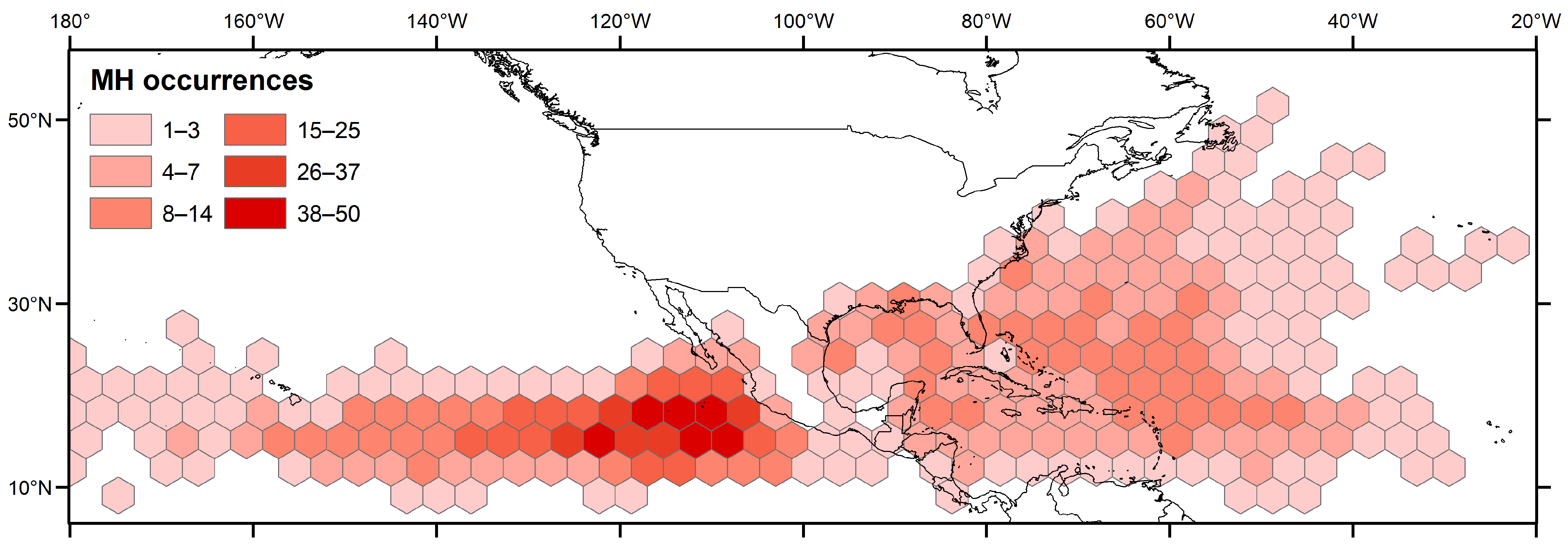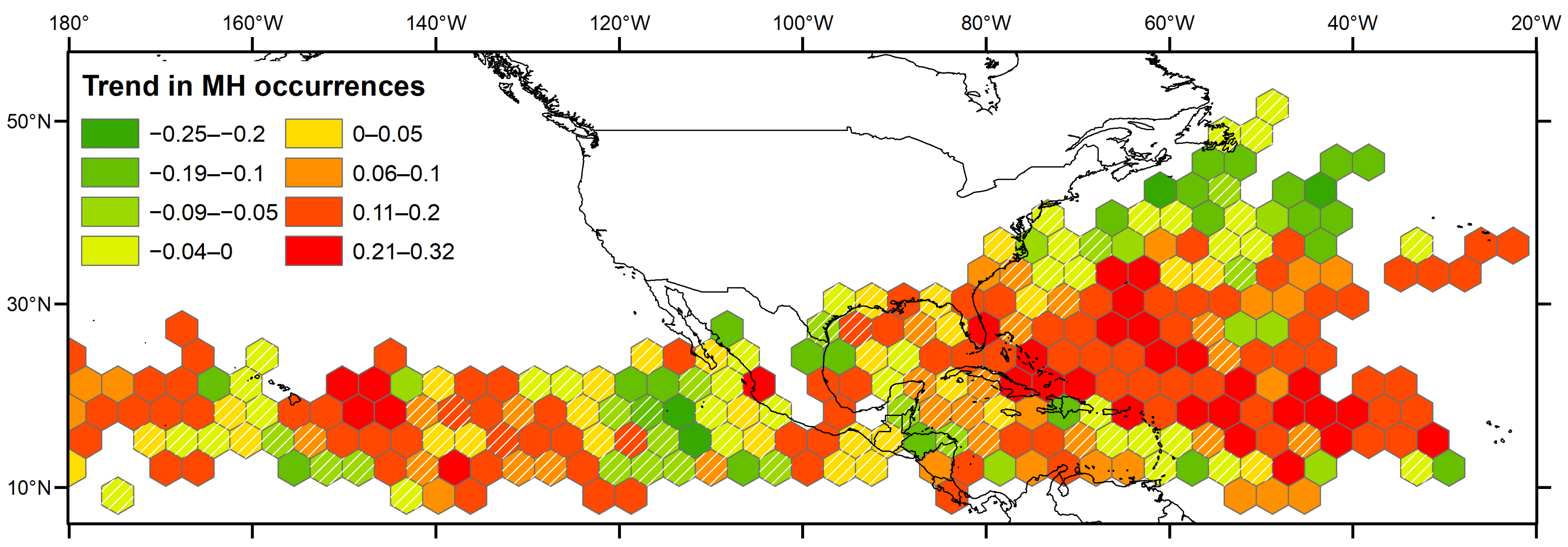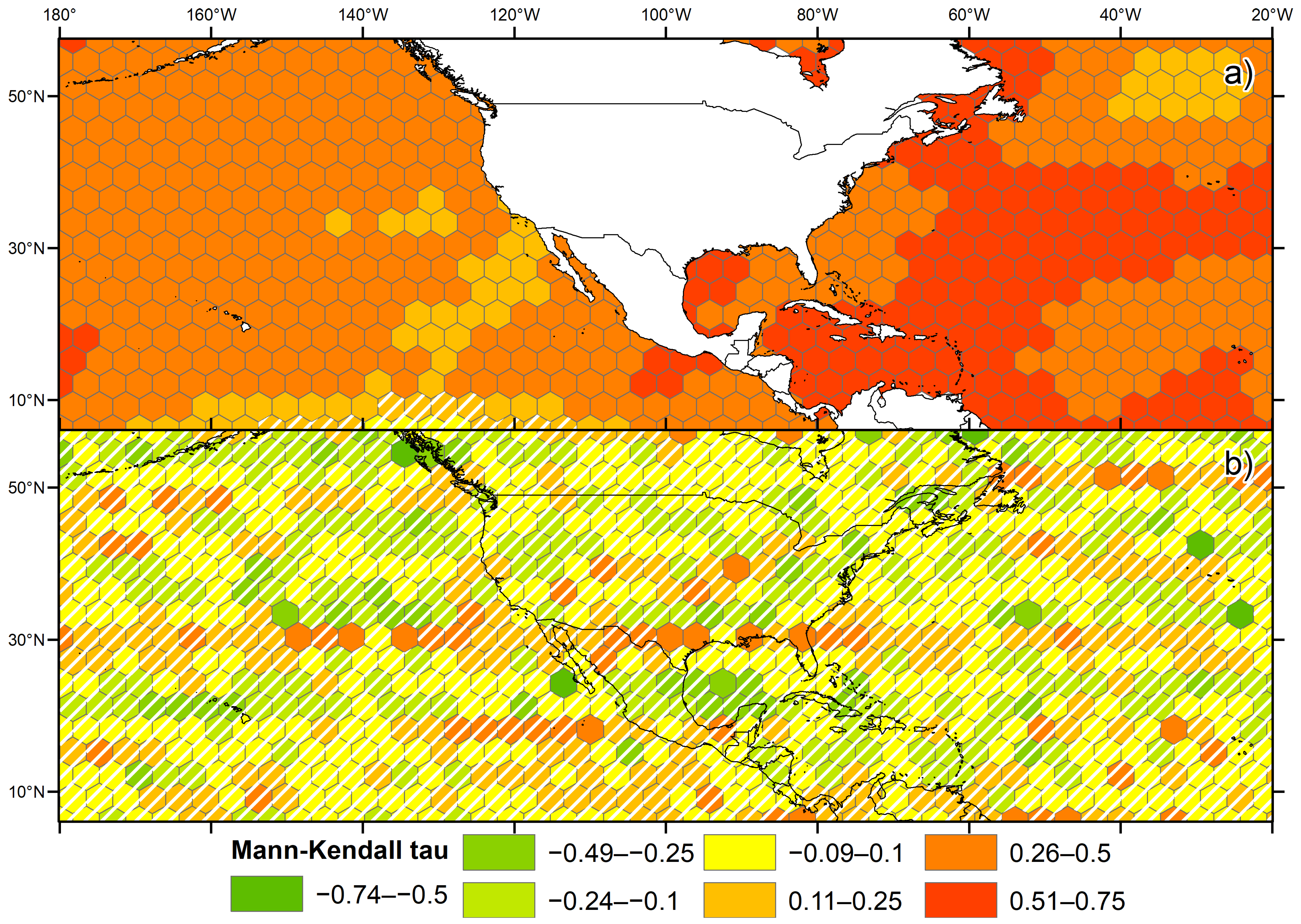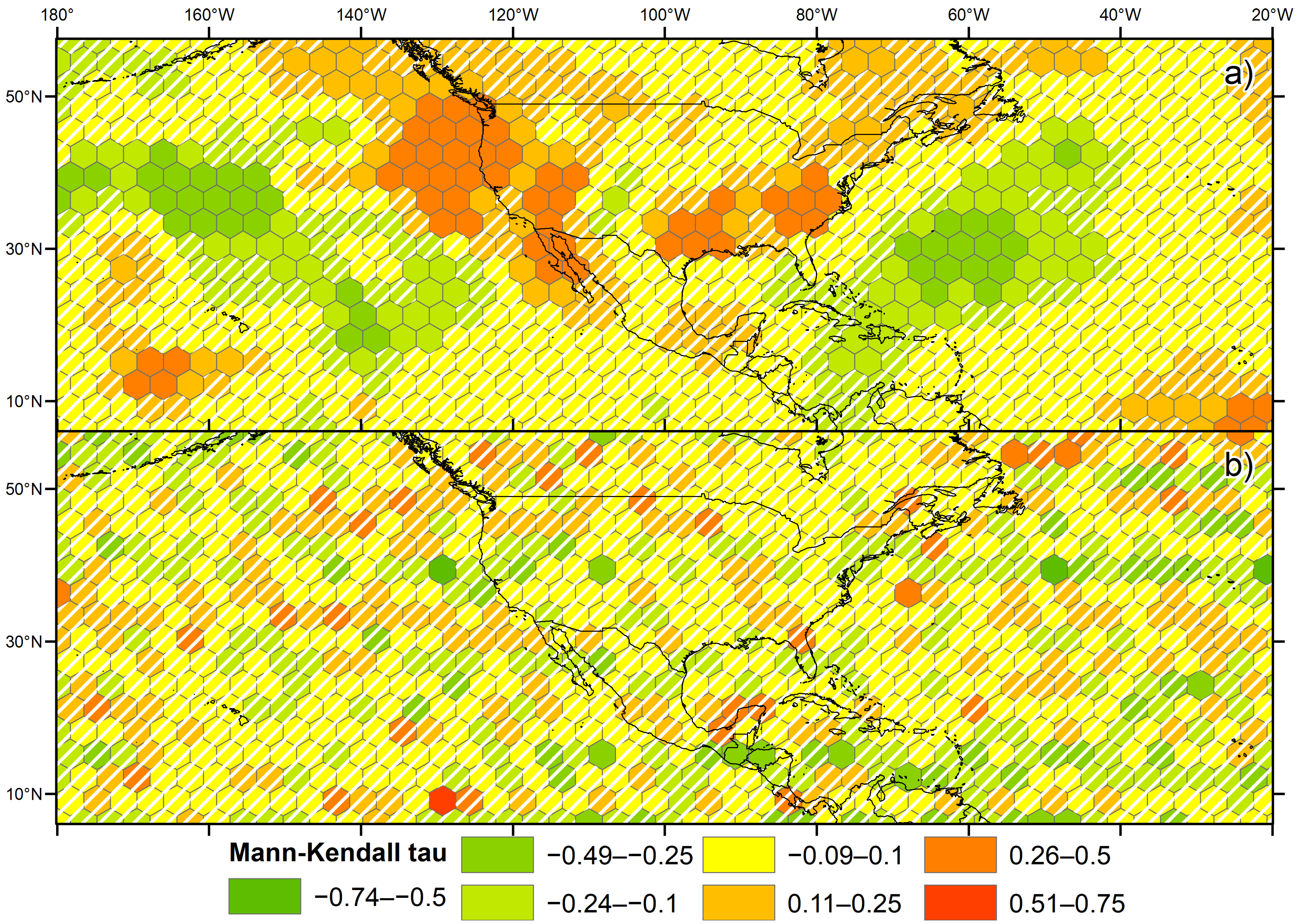Assessment of the Spatial Variation in the Occurrence and Intensity of Major Hurricanes in the Western Hemisphere
Abstract
1. Introduction
2. Materials and Methods
2.1. Tropical Cyclone Data
2.2. Oceanographic and Atmospheric Data
2.3. Sampling for Spatial Analysis
2.4. Trend Analysis
2.5. Creation of the Maps
2.6. Relation between MH and Physical Variables
3. Results
3.1. Occurrence of MHs
3.2. Intensity Trend
3.3. Trends in Local Occurrences
3.4. Relationship between MH Occurrences and Physical Variables
3.4.1. Multivariate Temporal Analysis
3.4.2. Multivariate Spatial Analysis
4. Discussion
5. Conclusions
Supplementary Materials
Author Contributions
Funding
Data Availability Statement
Conflicts of Interest
References
- CRED EM-DAT, The International Disaster Database. Available online: http://www.emdat.be/ (accessed on 10 April 2018).
- Sivakumar, M.V. Impacts of Natural Disasters in Agriculture, Rangeland and Forestry: An Overview. In Natural Disasters and Extreme Events in Agriculture; Springer: Berlin/Heidelberg, Germany, 2005; pp. 1–22. [Google Scholar]
- Nordhaus, W. The Economics of Hurricanes in the United States; National Bureau of Economic Research: Cambridge, MA, USA, 2006; p. w12813. [Google Scholar]
- Smith, A.B. U.S. Billion-Dollar Weather and Climate Disasters, 1980—Present (NCEI Accession 0209268); NOAA National Centers for Environmental Information Dataset: Washington, DC, USA, 2020. [CrossRef]
- Homewood, P. Tropical Hurricanes in the Age of Global Warming. GWPF Brief 2019, 37. [Google Scholar]
- Walsh, K.; Karoly, D.; Nicholls, N. Detection and Attribution of Climate Change Effects on Tropical Cyclones. In Hurricanes and Climate Change; Elsner, J.B., Jagger, T.H., Eds.; Springer: Boston, MA, USA, 2009; ISBN 978-0-387-09409-0. [Google Scholar]
- Knutson, T.R.; McBride, J.L.; Chan, J.; Emanuel, K.; Holland, G.; Landsea, C.; Held, I.; Kossin, J.P.; Srivastava, A.K.; Sugi, M. Tropical Cyclones and Climate Change. Nat. Geosci. 2010, 3, 157–163. [Google Scholar] [CrossRef]
- Walsh, K.; Lavender, S.; Murakami, H.; Scoccimarro, E.; Caron, L.-P.; Ghantous, M. The Tropical Cyclone Climate Model Intercomparison Project. In Hurricanes and Climate Change; Elsner, J.B., Hodges, R.E., Malmstadt, J.C., Scheitlin, K.N., Eds.; Springer: Dordrecht, The Netherlands, 2010; ISBN 978-90-481-9509-1. [Google Scholar]
- Kossin, J.P.; Camargo, S.J. Hurricane Track Variability and Secular Potential Intensity Trends. Clim. Change 2009, 97, 329–337. [Google Scholar] [CrossRef]
- Elsner, J.B.; Trepanier, J.C.; Strazzo, S.E.; Jagger, T.H. Sensitivity of Limiting Hurricane Intensity to Ocean Warmth: Sensitivity of the Strongest Hurricanes. Geophys. Res. Lett. 2012, 39, 1–6. [Google Scholar] [CrossRef]
- Frame, D.J.; Wehner, M.F.; Noy, I.; Rosier, S.M. The Economic Costs of Hurricane Harvey Attributable to Climate Change. Clim. Change 2020, 160, 271–281. [Google Scholar] [CrossRef]
- United Nations Office for Disaster Risk Reduction. 2009 UNISDR Terminology on Disaster Risk Reduction; United Nations Office for Disaster Risk Reduction: Geneva, Switzerland, 2009. [Google Scholar]
- Kossin, J.P.; Olander, T.L.; Knapp, K.R. Trend Analysis with a New Global Record of Tropical Cyclone Intensity. J. Clim. 2013, 26, 9960–9976. [Google Scholar] [CrossRef]
- Masson-Delmotte, V.; Zhai, P.; Pirani, A.; Connors, S.L.; Péan, C.; Berger, S.; Caud, N.; Chen, Y.; Goldfarb, L.; Gomis, M.; et al. Climate Change 2021: The Physical Science Basis; The Working Group I contribution to the Sixth Assessment Report; Intergovernmental Panel on Climate Change (IPCC): Geneva, Switzerland, 2021. [Google Scholar]
- Murakami, H.; Delworth, T.L.; Cooke, W.F.; Zhao, M.; Xiang, B.; Hsu, P.-C. Detected Climatic Change in Global Distribution of Tropical Cyclones. Proc. Natl. Acad. Sci. USA 2020, 117, 10706–10714. [Google Scholar] [CrossRef]
- Walsh, K.J.; McBride, J.L.; Klotzbach, P.J.; Balachandran, S.; Camargo, S.J.; Holland, G.; Knutson, T.R.; Kossin, J.P.; Lee, T.; Sobel, A.; et al. Tropical Cyclones and Climate Change. Wiley Interdiscip. Rev. Clim. Change 2016, 7, 65–89. [Google Scholar] [CrossRef]
- Niwa, Y.; Hibiya, T. Nonlinear Processes of Energy Transfer from Traveling Hurricanes to the Deep Ocean Internal Wave Field. J. Geophys. Res. Ocean. 1997, 102, 12469–12477. [Google Scholar] [CrossRef]
- Emanuel, K. Increasing Destructiveness of Tropical Cyclones over the Past 30 Years. Nature 2005, 436, 686–688. [Google Scholar] [CrossRef]
- Goldenberg, S.B. The Recent Increase in Atlantic Hurricane Activity: Causes and Implications. Science 2001, 293, 474–479. [Google Scholar] [CrossRef] [PubMed]
- Webster, P.J. Changes in Tropical Cyclone Number, Duration, and Intensity in a Warming Environment. Science 2005, 309, 1844–1846. [Google Scholar] [CrossRef] [PubMed]
- Wang, C.; Lee, S.-K.; Enfield, D.B. Atlantic Warm Pool Acting as a Link between Atlantic Multidecadal Oscillation and Atlantic Tropical Cyclone Activity. Geochem. Geophys. Geosystems 2008, 9, 1–17. [Google Scholar] [CrossRef]
- Poore, R.Z.; Brock, J. Evidence of Multidecadal Climate Variability in the Gulf of Mexico; Fact Sheet; U.S. Geological Survey: Reston, VA, USA, 2011; Volume 2011–3027, p. 2.
- Kossin, J.P.; Knapp, K.R.; Vimont, D.J.; Murnane, R.J.; Harper, B.A. A Globally Consistent Reanalysis of Hurricane Variability and Trends. Geophys. Res. Lett. 2007, 34, 1–6. [Google Scholar] [CrossRef]
- André, J.-C.; Royer, J.-F.; Chauvin, F. Les cyclones tropicaux et le changement climatique. Comptes Rendus Geosci. 2008, 340, 575–583. [Google Scholar] [CrossRef]
- Tennille, S.A.; Ellis, K.N. Spatial and Temporal Trends in the Location of the Lifetime Maximum Intensity of Tropical Cyclones. Atmosphere 2017, 8, 198. [Google Scholar] [CrossRef]
- Knapp, K.R.; Kruk, M.C.; Levinson, D.H.; Diamond, H.J.; Neumann, C.J. The International Best Track Archive for Climate Stewardship (IBTrACS): Unifying Tropical Cyclone Data. Bull. Am. Meteorol. Soc. 2010, 91, 363–376. [Google Scholar] [CrossRef]
- Knapp, K.R.; Diamond, H.J.; Kossin, J.P.; Kruk, M.C.; Schreck, C.J.I. International Best Track Archive for Climate Stewardship (IBTrACS) Project, Version 4. NOAA National Centers for Environmental Information. Available online: https://www.ncei.noaa.gov/data/international-best-track-archive-for-climate-stewardship-ibtracs/v04r00/access/ (accessed on 10 July 2022).
- Vecchi, G.A.; Knutson, T.R. Estimating Annual Numbers of Atlantic Hurricanes Missing from the HURDAT Database (1878–1965) Using Ship Track Density. J. Clim. 2011, 24, 1736–1746. [Google Scholar] [CrossRef]
- Farfán, L.M.; Alfaro, E.J.; Cavazos, T. Characteristics of Tropical Cyclones Making Landfall on the Pacific Coast of Mexico: 1970–2010. Atmósfera 2013, 26, 163–182. [Google Scholar] [CrossRef]
- Elms, J.D.; Neumann, C.J.; United States, National Environmental Satellite, Data, and Information Service; United States, National Weather Service; National Hurricane Center (U.S.); National Climatic Data Center (U.S.). Tropical Cyclones of the North Atlantic Ocean, 1871–1992; Historical Climatology Series; National Climatic Data Center: Asheville, NC, USA, 1993.
- Landsea, C.W. Atlantic Hurricane Database Uncertainty and Presentation of a New Database Format. Mon. Weather Rev. 2013, 141, 3576–3592. [Google Scholar] [CrossRef]
- Lee, H.S.; Yamashita, T.; Mishima, T. Multi-Decadal Variations of ENSO, the Pacific Decadal Oscillation and Tropical Cyclones in the Western North Pacific. Prog. Oceanogr. 2012, 105, 67–80. [Google Scholar] [CrossRef]
- Liu, K.S.; Chan, J.C.L. Inactive Period of Western North Pacific Tropical Cyclone Activity in 1998–2011. J. Clim. 2013, 26, 2614–2630. [Google Scholar] [CrossRef]
- Huang, B.; Thorne, P.W.; Banzon, V.F.; Boyer, T.; Chepurin, G.; Lawrimore, J.H.; Menne, M.J.; Smith, T.M.; Vose, R.S.; Zhang, H.-M. Extended Reconstructed Sea Surface Temperature, Version 5 (ERSSTv5): Upgrades, Validations, and Intercomparisons. J. Clim. 2017, 30, 8179–8205. [Google Scholar] [CrossRef]
- Kalnay, E.; Kanamitsu, M.; Kistler, R.; Collins, W.; Deaven, D.; Gandin, L.; Iredell, M.; Saha, S.; White, G.; Woollen, J.; et al. The NCEP/NCAR 40-Year Reanalysis Project. Bull. Am. Meteorol. Soc. 1996, 77, 437–472. [Google Scholar] [CrossRef]
- Moon, I.-J.; Kim, S.-H.; Klotzbach, P.; Chan, J.C.L. Roles of Interbasin Frequency Changes in the Poleward Shifts of the Maximum Intensity Location of Tropical Cyclones. Environ. Res. Lett. 2015, 10, 104004. [Google Scholar] [CrossRef]
- Jones, P.D.; Jonsson, T.; Wheeler, D. Extension to the North Atlantic Oscillation Using Early Instrumental Pressure Observations from Gibraltar and South-West Iceland. Int. J. Climatol. 1997, 17, 1433–1450. [Google Scholar] [CrossRef]
- Oliver, J.E. Pacific North American Oscillation (Pna). In Encyclopedia of World Climatology; Oliver, J.E., Ed.; Springer: Dordrecht, The Netherlands, 2005; pp. 563–564. ISBN 978-1-4020-3266-0. [Google Scholar]
- Trenberth, K.E.; Stepaniak, D.P. Indices of El Niño Evolution. J. Clim. 2001, 14, 1697–1701. [Google Scholar] [CrossRef]
- Enfield, D.B.; Mestas-Nuñez, A.M.; Mayer, D.A.; Cid-Serrano, L. How Ubiquitous Is the Dipole Relationship in Tropical Atlantic Sea Surface Temperatures? J. Geophys. Res. Ocean. 1999, 104, 7841–7848. [Google Scholar] [CrossRef]
- Amador, J.; Durán-quesada, A.; Rivera, E.; Mora, G.; Sáenz, F.; Calderon, B.; Mora, N. The Easternmost Tropical Pacific. Part II: Seasonal and Intraseasonal Modes of Atmospheric Variability. Rev. Biol. Trop. 2016, 64, 23–57. [Google Scholar] [CrossRef]
- Fraza, E.; Elsner, J.B. A Spatial Climatology of North Atlantic Hurricane Intensity Change: Spatial Climatology of North Atlantic TC Intensity Change. Int. J. Climatol. 2014, 34, 2918–2924. [Google Scholar] [CrossRef]
- Chen, J.; Chavas, D.R. Can Existing Theory Predict the Response of Tropical Cyclone Intensity to Idealized Landfall? J. Atmos. Sci. 2021, 78, 3281–3296. [Google Scholar] [CrossRef]
- Knutson, T.; Camargo, S.J.; Chan, J.C.L.; Emanuel, K.; Ho, C.-H.; Kossin, J.; Mohapatra, M.; Satoh, M.; Sugi, M.; Walsh, K.; et al. Tropical Cyclones and Climate Change Assessment: Part II: Projected Response to Anthropogenic Warming. Bull. Am. Meteorol. Soc. 2020, 101, 20. [Google Scholar] [CrossRef]
- Elsner, J.B.; Hodges, R.E.; Jagger, T.H. Spatial Grids for Hurricane Climate Research. Clim. Dyn. 2011, 39, 21–36. [Google Scholar] [CrossRef]
- Pebesma, E.J. Simple Features for R: Standardized Support for Spatial Vector Data. R J. 2018, 10, 439–446. [Google Scholar] [CrossRef]
- R Core Team. R: A Language and Environment for Statistical Computing; R Foundation for Statistical Computing: Vienna, Austria, 2020. [Google Scholar]
- Hijmans, R.J.; van Etten, J.; Mattiuzzi, M.; Sumner, M.; Greenberg, J.A.; Lamigueiro, O.P.; Bevan, A.; Racine, E.B.; Shortridge, A. Raster: Geographic Data Analysis and Modeling; CRAN: Vienna, Austria, 2015. [Google Scholar]
- Wickham, H.; François, R.; Henry, L.; Müller, K. Dplyr: A Grammar of Data Manipulation; RStudio: Boston, MA, USA, 2020. [Google Scholar]
- Elsner, J.; Jagger, T. Hurricane Climatology: A Modern Statistical Guide Using R; Oxford University Press: Oxford, UK, 2013; ISBN 978-0-19-982763-3. [Google Scholar]
- Bender, M.A.; Knutson, T.R.; Tuleya, R.E.; Sirutis, J.J.; Vecchi, G.A.; Garner, S.T.; Held, I.M. Modeled Impact of Anthropogenic Warming on the Frequency of Intense Atlantic Hurricanes. Science 2010, 327, 454–458. [Google Scholar] [CrossRef]
- Knutson, T.R.; Sirutis, J.J.; Vecchi, G.A.; Garner, S.; Zhao, M.; Kim, H.-S.; Bender, M.; Tuleya, R.E.; Held, I.M.; Villarini, G. Dynamical Downscaling Projections of Twenty-First-Century Atlantic Hurricane Activity: CMIP3 and CMIP5 Model-Based Scenarios. J. Clim. 2013, 26, 6591–6617. [Google Scholar] [CrossRef]
- McLeod, A.I. Kendall: Kendall Rank Correlation and Mann-Kendall Trend Test; CRAN: Vienna, Austria, 2022. [Google Scholar]
- Mann, H.B. Nonparametric Tests against Trend. Econom. J. Econom. Soc. 1945, 13, 245–259. [Google Scholar] [CrossRef]
- Kendall, M.G. Rank Correlation Methods; Griffin: London, UK, 1948. [Google Scholar]
- Huang, W.; Dong, S. Long-Term and Inter-Annual Variations of Tropical Cyclones Affecting Taiwan Region. Reg. Stud. Mar. Sci. 2019, 30, 100721. [Google Scholar] [CrossRef]
- Gu, X.; Zhang, Q.; Singh, V.P.; Liu, L.; Shi, P. Spatiotemporal Patterns of Annual and Seasonal Precipitation Extreme Distributions across China and Potential Impact of Tropical Cyclones. Int. J. Climatol. 2017, 37, 3949–3962. [Google Scholar] [CrossRef]
- Schneider, G.; Chicken, E.; Becvarik, R. NSM3: Functions and Datasets to Accompany Hollander, Wolfe, and Chicken—Nonparametric Statistical Methods, 3rd ed.; CRAN: Vienna, Austria, 2022. [Google Scholar]
- Murtaugh, P.A. In Defense of P Values. Ecology 2014, 95, 611–617. [Google Scholar] [CrossRef]
- Moran, P.A. Notes on Continuous Stochastic Phenomena. Biometrika 1950, 37, 17–23. [Google Scholar] [CrossRef] [PubMed]
- James, G.; Witten, D.; Hastie, T.; Tibshirani, R. An Introduction to Statistical Learning: With Applications in R; Springer Texts in Statistics; Springer: New York, NY, USA, 2013; ISBN 978-1-4614-7137-0. [Google Scholar]
- Bruce, P.; Bruce, A. Practical Statistics for Data Scientists: 50 Essential Concepts; O’Reilly Media, Inc.: Sebastopol, CA, USA, 2017; ISBN 978-1-4919-5293-1. [Google Scholar]
- Lumley, T. Based on Fortran Code by Miller A. Leaps: Regression Subset Selection. 2010. Available online: https://CRAN.R-project.org/package=leaps (accessed on 22 June 2022).
- Ripley, B.; Venables, B.; Bates, D.M.; Hornik, K.; Gebhardt, A.; Firth, D. MASS: Support Functions and Datasets for Venables and Ripley’s MASS; CRAN: Vienna, Austria, 2021. [Google Scholar]
- Akaike, H. A New Look at the Statistical Model Identification. IEEE Trans. Autom. Control. 1974, 19, 716–723. [Google Scholar] [CrossRef]
- Dunn, P.K.; Smyth, G.K. Generalized Linear Models with Examples in R; Springer: New York, NY, USA, 2018; Volume 53. [Google Scholar]
- Bell, G.D.; Chelliah, M. Leading Tropical Modes Associated with Interannual and Multidecadal Fluctuations in North Atlantic Hurricane Activity. J. Clim. 2006, 19, 590–612. [Google Scholar] [CrossRef]
- Goldenberg, S.B.; Shapiro, L.J. Physical Mechanisms for the Association of El Niño and West African Rainfall with Atlantic Major Hurricane Activity. J. Clim. 1996, 9, 1169–1187. [Google Scholar] [CrossRef]
- Zhu, X.; Saravanan, R.; Chang, P. Influence of Mean Flow on the ENSO–Vertical Wind Shear Relationship over the Northern Tropical Atlantic. J. Clim. 2012, 25, 858–864. [Google Scholar] [CrossRef]
- Shaman, J.; Maloney, E.D. Shortcomings in Climate Model Simulations of the ENSO-Atlantic Hurricane Teleconnection. Clim. Dyn. 2012, 38, 1973–1988. [Google Scholar] [CrossRef]
- Alfaro, E.J. Escenarios climáticos para temporadas con alto y bajo número de huracanes en el Atlántico. Rev. Climatol. 2007, 7, 14. [Google Scholar]
- Holland, G.; Bruyère, C.L. Recent Intense Hurricane Response to Global Climate Change. Clim. Dyn. 2014, 42, 617–627. [Google Scholar] [CrossRef]
- NOAA Atlantic High-Activity Eras: What Does It Mean for Hurricane Season?|National Oceanic and Atmospheric Administration. Available online: https://www.noaa.gov/stories/atlantic-high-activity-eras-what-does-it-mean-for-hurricane-season (accessed on 25 June 2021).
- Moon, I.-J.; Kim, S.-H.; Chan, J.C.L. Climate Change and Tropical Cyclone Trend. Nature 2019, 570, E3–E5. [Google Scholar] [CrossRef]
- Knutson, T.R.; Sirutis, J.J.; Zhao, M.; Tuleya, R.E.; Bender, M.; Vecchi, G.A.; Villarini, G.; Chavas, D. Global Projections of Intense Tropical Cyclone Activity for the Late Twenty-First Century from Dynamical Downscaling of CMIP5/RCP4.5 Scenarios. J. Clim. 2015, 28, 7203–7224. [Google Scholar] [CrossRef]
- Knutson, T.; Camargo, S.J.; Chan, J.C.L.; Emanuel, K.; Ho, C.-H.; Kossin, J.; Mohapatra, M.; Satoh, M.; Sugi, M.; Walsh, K.; et al. Tropical Cyclones and Climate Change Assessment: Part I: Detection and Attribution. Bull. Am. Meteorol. Soc. 2019, 100, 1987–2007. [Google Scholar] [CrossRef]
- Castro Lopez, J.; Zavala Trujillo, B.; Figueroa Lara, A. La física de los huracanes Paulina y Patricia en su paso por el pacífico mexicano. Rev. Mex. Física E 2020, 17, 33. [Google Scholar] [CrossRef]
- Nystrom, R.G.; Zhang, F. Practical Uncertainties in the Limited Predictability of the Record-Breaking Intensification of Hurricane Patricia (2015). Mon. Weather Rev. 2019, 147, 3535–3556. [Google Scholar] [CrossRef]
- Arora, K.; Dash, P. Towards Dependence of Tropical Cyclone Intensity on Sea Surface Temperature and Its Response in a Warming World. Climate 2016, 4, 30. [Google Scholar] [CrossRef]
- Klotzbach, P.J.; Schreck, C.J., III; Collins, J.M.; Bell, M.M.; Blake, E.S.; Roache, D. The Extremely Active 2017 North Atlantic Hurricane Season. Mon. Weather Rev. 2018, 146, 3425–3443. [Google Scholar] [CrossRef]
- Gutzler, D.S. Interannual Variability of Tropical Cyclone Activity along the Pacific Coast of North America. Atmósfera 2013, 26, 149–162. [Google Scholar] [CrossRef]
- Ralph, T.U.; Gough, W.A. The Influence of Sea-Surface Temperatures on Eastern North Pacific Tropical Cyclone Activity. Theor. Appl. Climatol. 2009, 95, 257–264. [Google Scholar] [CrossRef]
- Gray, W.M. Atlantic Seasonal Hurricane Frequency. Part I: El Niño and 30 Mb Quasi-Biennial Oscillation Influences. Mon. Weather Rev. 1984, 112, 1649–1668. [Google Scholar] [CrossRef]
- McTaggart-Cowan, R.; Davies, E.L.; Fairman, J.G.; Galarneau, T.J.; Schultz, D.M. Revisiting the 26.5 °C Sea Surface Temperature Threshold for Tropical Cyclone Development. Bull. Am. Meteorol. Soc. 2015, 96, 1929–1943. [Google Scholar] [CrossRef]
- Bang, H.N.; Miles, L.S.; Gordon, R.D. Hurricane Occurrence and Seasonal Activity: An Analysis of the 2017 Atlantic Hurricane Season. Am. J. Clim. Change 2019, 8, 454–481. [Google Scholar] [CrossRef][Green Version]
- NOAA; National Centers for Environmental Information. State of the Climate—Global Analysis. Available online: https://www.ncei.noaa.gov/access/metadata/landing-page/bin/iso?id=gov.noaa.ncdc:C00672 (accessed on 28 June 2021).
- Kerry, E. Divine Wind: The History and Science of Hurricanes; Oxford University Press: Oxford, UK, 2005; ISBN 978-0-19-514941-8. [Google Scholar]
- Hall, T.; Tippett, M.K. Pacific Hurricane Landfalls on Mexico and SST. J. Appl. Meteorol. Climatol. 2017, 56, 667–676. [Google Scholar] [CrossRef] [PubMed]
- Lau, W.; Zhou, Y. Observed Recent Trends in Tropical Cyclone Rainfall over the North Atlantic and the North Pacific. J. Geophys. Res. Atmos. 2012, 117, 3104. [Google Scholar] [CrossRef]
- Mousavi, M.E.; Irish, J.L.; Frey, A.E.; Olivera, F.; Edge, B.L. Global Warming and Hurricanes: The Potential Impact of Hurricane Intensification and Sea Level Rise on Coastal Flooding. Clim. Change 2011, 104, 575–597. [Google Scholar] [CrossRef]
- Knutson, T. Global Warming and Hurricanes. Available online: https://www.gfdl.noaa.gov/global-warming-and-hurricanes/ (accessed on 30 June 2021).
- Hoyos, C.D.; Agudelo, P.A.; Webster, P.J.; Curry, J.A. Deconvolution of the Factors Contributing to the Increase in Global Hurricane Intensity. Science 2006, 312, 94–97. [Google Scholar] [CrossRef] [PubMed]







| Basin | Period | n | Moran’s Index | p-Value |
|---|---|---|---|---|
| NEP | 1970–1995 | 77 | 0.4181 | 0 |
| NEP | 1996–2021 | 90 | 0.3137 | 0 |
| NA | 1970–1995 | 123 | 0.0761 | 0.0015 |
| NA | 1996–2021 | 151 | 0.2784 | 0 |
| Basin | Index | Estimate | p-Values | PED |
|---|---|---|---|---|
| NA | NIÑO34 | −0.309 | 0.005 | 11.0% |
| TNI | −0.151 | 0.025 | 7.0% | |
| TNA | 0.346 | >0.001 | 24.3% | |
| NEP | TNI | 0.265 | 0.059 | 3.4% |
| TNA | −0.224 | 0.147 | 2.0% | |
| SST | 0.414 | 0.000 | 32.9% |
| Variable | Estimated Coefficient | p-Values | PED |
|---|---|---|---|
| SLP tau | −0.012 | 0.009 | 1.3% |
| SST mean | 0.023 | >0.001 | 24.8% |
Disclaimer/Publisher’s Note: The statements, opinions and data contained in all publications are solely those of the individual author(s) and contributor(s) and not of MDPI and/or the editor(s). MDPI and/or the editor(s) disclaim responsibility for any injury to people or property resulting from any ideas, methods, instructions or products referred to in the content. |
© 2023 by the authors. Licensee MDPI, Basel, Switzerland. This article is an open access article distributed under the terms and conditions of the Creative Commons Attribution (CC BY) license (https://creativecommons.org/licenses/by/4.0/).
Share and Cite
Martinez, L.-C.; Romero, D.; Alfaro, E.J. Assessment of the Spatial Variation in the Occurrence and Intensity of Major Hurricanes in the Western Hemisphere. Climate 2023, 11, 15. https://doi.org/10.3390/cli11010015
Martinez L-C, Romero D, Alfaro EJ. Assessment of the Spatial Variation in the Occurrence and Intensity of Major Hurricanes in the Western Hemisphere. Climate. 2023; 11(1):15. https://doi.org/10.3390/cli11010015
Chicago/Turabian StyleMartinez, Luis-Carlos, David Romero, and Eric J. Alfaro. 2023. "Assessment of the Spatial Variation in the Occurrence and Intensity of Major Hurricanes in the Western Hemisphere" Climate 11, no. 1: 15. https://doi.org/10.3390/cli11010015
APA StyleMartinez, L.-C., Romero, D., & Alfaro, E. J. (2023). Assessment of the Spatial Variation in the Occurrence and Intensity of Major Hurricanes in the Western Hemisphere. Climate, 11(1), 15. https://doi.org/10.3390/cli11010015









